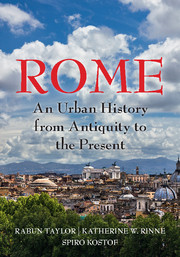Book contents
- Frontmatter
- Dedication
- Epigraph
- Contents
- List of Illustrations
- Acknowledgments
- Map
- INTRODUCTION
- 1 A BEND IN THE RIVER
- 2 A STORYBOOK BEGINNING
- 3 IDEOLOGICAL CROSSFIRE
- 4 BIG MEN ON THE CAMPUS
- 5 RES PUBLICA RESTITUTA
- 6 MEMORIALS IN MOTION: SPECTACLE IN THE CITY
- 7 THE CONCRETE STYLE
- 8 REMAKING ROME'S PUBLIC CORE: I
- 9 REMAKING ROME'S PUBLIC CORE: II
- 10 CRISIS AND CONTINUITY
- 11 RUS IN URBE: A GARDEN CITY
- 12 ADMINISTRATION, INFRASTRUCTURE, AND DISPOSAL OF THE DEAD
- 13 MAPPING, ZONING, AND SEQUESTRATION
- 14 TETRARCHIC AND CONSTANTINIAN ROME
- 15 TROPHIES AND TITULI: CHRISTIAN INFRASTRUCTURE BEFORE CONSTANTINE
- 16 WALLS MAKE CHRISTIANS: FROM FOURTH TO FIFTH CENTURY
- 17 A TALE OF TWO ROMES
- 18 THE ROME OF GOTHS AND BYZANTINES
- 19 CHRISTIAN FOUNDATIONS
- 20 FROM DOMUS LATERANI TO ROMANUM PALATIUM
- 21 THE LEONINE CITY: ST. PETER'S AND THE BORGO
- 22 VIA PAPALIS, THE CHRISTIAN DECUMANUS
- 23 THE URBAN THEATERS OF IMPERIUM AND SPQR
- 24 HOUSING DAILY LIFE
- 25 CHAOS IN THE FORTIFIED CITY
- 26 THE TIBER RIVER
- 27 HUMANIST ROME, ABSOLUTIST ROME (1420–1527)
- 28 PLANNING COUNTER REFORMATION ROME
- 29 PROCESSIONS AND POPULATIONS
- 30 MAGNIFICENT PALACES AND RHETORICAL CHURCHES
- 31 NEOCLASSICAL ROME
- 32 PICTURING ROME
- 33 REVOLUTION AND RISORGIMENTO
- 34 ITALIAN NATIONALISM AND ROMANITÀ
- 35 A CITY TURNED INSIDE OUT
- Glossary of Persons, Places, and Terms
- Works Cited
- Index
3 - IDEOLOGICAL CROSSFIRE
Published online by Cambridge University Press: 05 July 2016
- Frontmatter
- Dedication
- Epigraph
- Contents
- List of Illustrations
- Acknowledgments
- Map
- INTRODUCTION
- 1 A BEND IN THE RIVER
- 2 A STORYBOOK BEGINNING
- 3 IDEOLOGICAL CROSSFIRE
- 4 BIG MEN ON THE CAMPUS
- 5 RES PUBLICA RESTITUTA
- 6 MEMORIALS IN MOTION: SPECTACLE IN THE CITY
- 7 THE CONCRETE STYLE
- 8 REMAKING ROME'S PUBLIC CORE: I
- 9 REMAKING ROME'S PUBLIC CORE: II
- 10 CRISIS AND CONTINUITY
- 11 RUS IN URBE: A GARDEN CITY
- 12 ADMINISTRATION, INFRASTRUCTURE, AND DISPOSAL OF THE DEAD
- 13 MAPPING, ZONING, AND SEQUESTRATION
- 14 TETRARCHIC AND CONSTANTINIAN ROME
- 15 TROPHIES AND TITULI: CHRISTIAN INFRASTRUCTURE BEFORE CONSTANTINE
- 16 WALLS MAKE CHRISTIANS: FROM FOURTH TO FIFTH CENTURY
- 17 A TALE OF TWO ROMES
- 18 THE ROME OF GOTHS AND BYZANTINES
- 19 CHRISTIAN FOUNDATIONS
- 20 FROM DOMUS LATERANI TO ROMANUM PALATIUM
- 21 THE LEONINE CITY: ST. PETER'S AND THE BORGO
- 22 VIA PAPALIS, THE CHRISTIAN DECUMANUS
- 23 THE URBAN THEATERS OF IMPERIUM AND SPQR
- 24 HOUSING DAILY LIFE
- 25 CHAOS IN THE FORTIFIED CITY
- 26 THE TIBER RIVER
- 27 HUMANIST ROME, ABSOLUTIST ROME (1420–1527)
- 28 PLANNING COUNTER REFORMATION ROME
- 29 PROCESSIONS AND POPULATIONS
- 30 MAGNIFICENT PALACES AND RHETORICAL CHURCHES
- 31 NEOCLASSICAL ROME
- 32 PICTURING ROME
- 33 REVOLUTION AND RISORGIMENTO
- 34 ITALIAN NATIONALISM AND ROMANITÀ
- 35 A CITY TURNED INSIDE OUT
- Glossary of Persons, Places, and Terms
- Works Cited
- Index
Summary
THE NEWLY WALLED CITY WAS A RAGGED THOUSAND-ACRE QUILT OF medium-density development patched about by sacred groves, sanctuaries, and tracts of suburban farms that would later be absorbed into horti, great aristocratic garden estates (see Chapter 11). Most of its area, hosting perhaps 40,000 residents in all, was subdivided into four large regions, each corresponding to an urban tribe of citizens: Subura, Esquilina, Collina, Palatina. Westward lay the lonely extramural expanse of the Campus Martius – “Field of Mars.” Its only man-made precinct was the Villa Publica, where at a venerable altar of the war god, the Ara Martis, the general census was periodically taken and soldiers were conscribed. In time, the magistrates overseeing these duties, the censors, would also come to dominate secular construction in Rome.
The fourth century B.C.E. witnessed profound changes in Roman social and political life, mostly along two intertwined paths: proletarization and militarization. Against fierce patrician opposition, the plebeians won the right to hold Rome's premier magistracy, the consulship, in 367. To mark the uneasy class realignment a new goddess was contrived in the abstract, allegorical manner characteristic of the Greeks: Concordia. Her temple was built on the Forum's northwestern rise, perched watchfully over the people's Comitium and the Curia, or Senate house, adjoining it (Fig. 11). Henceforth former consuls of both classes would erect temples at Rome. As military commanders, they conventionally vowed a new temple to a tutelary god while on campaign. If victorious, they fulfilled the vow (votum) at Rome afterward from the proceeds of war spoils. Temples of this sort are called votive.
Roman success in the Samnite Wars of the second half of the fourth century precipitated a flurry of victory temples back home. By 270 Rome controlled peninsular Italy, and the consequent influx of slaves had swelled the city's population to as much as 200,000. The dedication of votive temples was in full spate (Fig. 12). New kinds of war monuments emerged as well. In 338, the conqueror of the Latins, the plebeian Gaius Maenius, celebrated Rome's first naval victory by mounting a speaker's platform on one side of the Comitium. Perhaps from the very start it bristled with the bronze battering rams of ships Maenius had conquered. Called the Rostra (“beaks”), this platform and later imitations would become fixtures of Roman forensic politics.
- Type
- Chapter
- Information
- RomeAn Urban History from Antiquity to the Present, pp. 19 - 31Publisher: Cambridge University PressPrint publication year: 2016



